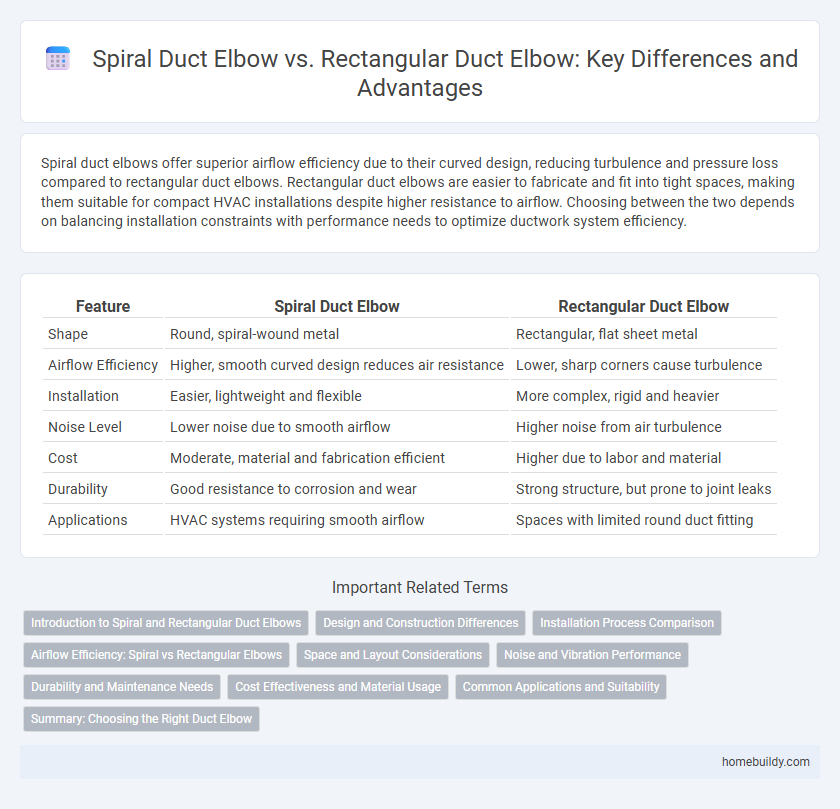Spiral duct elbows offer superior airflow efficiency due to their curved design, reducing turbulence and pressure loss compared to rectangular duct elbows. Rectangular duct elbows are easier to fabricate and fit into tight spaces, making them suitable for compact HVAC installations despite higher resistance to airflow. Choosing between the two depends on balancing installation constraints with performance needs to optimize ductwork system efficiency.
Table of Comparison
| Feature | Spiral Duct Elbow | Rectangular Duct Elbow |
|---|---|---|
| Shape | Round, spiral-wound metal | Rectangular, flat sheet metal |
| Airflow Efficiency | Higher, smooth curved design reduces air resistance | Lower, sharp corners cause turbulence |
| Installation | Easier, lightweight and flexible | More complex, rigid and heavier |
| Noise Level | Lower noise due to smooth airflow | Higher noise from air turbulence |
| Cost | Moderate, material and fabrication efficient | Higher due to labor and material |
| Durability | Good resistance to corrosion and wear | Strong structure, but prone to joint leaks |
| Applications | HVAC systems requiring smooth airflow | Spaces with limited round duct fitting |
Introduction to Spiral and Rectangular Duct Elbows
Spiral duct elbows feature a rounded, circular cross-section that enables smoother airflow and reduced resistance within HVAC systems, optimizing energy efficiency. Rectangular duct elbows, characterized by their angular design, are commonly used in spaces requiring specific directional changes but may cause higher turbulence and pressure loss. Choosing between spiral and rectangular duct elbows depends on system requirements for airflow efficiency, space constraints, and installation preferences.
Design and Construction Differences
Spiral duct elbows feature a cylindrical shape formed by spirally wound metal, offering enhanced airflow efficiency and reduced turbulence compared to rectangular duct elbows, which are constructed from flat sheet metal joined at perpendicular angles. The design of spiral duct elbows allows for smoother transitions and fewer sharp corners, minimizing friction loss and noise in HVAC systems, while rectangular elbows provide easier installation in tight spaces and compatibility with standard rectangular ductwork. Construction-wise, spiral elbows require precise rolling and welding techniques to maintain their curved profile, whereas rectangular elbows rely on sheet metal bending and seam sealing, impacting both cost and airflow performance.
Installation Process Comparison
Spiral duct elbows offer a streamlined installation process due to their round shape, allowing for easier alignment and sealing with spiral ducts, which reduces labor time and potential leakage. Rectangular duct elbows require precise measurements and additional sealing steps to ensure airtight connections, often increasing installation complexity. Choosing spiral duct elbows can enhance efficiency in HVAC systems where quick assembly and durability are priorities.
Airflow Efficiency: Spiral vs Rectangular Elbows
Spiral duct elbows offer superior airflow efficiency due to their smooth, curved design, minimizing turbulence and pressure drop compared to rectangular duct elbows, which have sharp corners that disrupt airflow and increase resistance. The continuous spiral form promotes laminar flow, enhancing HVAC system performance and energy efficiency. In contrast, rectangular elbows tend to generate eddies and turbulence, leading to higher energy consumption and reduced air distribution effectiveness.
Space and Layout Considerations
Spiral duct elbows offer a compact design with a circular cross-section that facilitates smoother airflow and occupies less space, making them ideal for tight or curved ductwork layouts. Rectangular duct elbows require more room due to their larger footprint and sharper bends, which can restrict airflow and complicate installation in confined spaces. Choosing spiral duct elbows optimizes spatial efficiency and enhances system performance in complex HVAC layouts.
Noise and Vibration Performance
Spiral duct elbows exhibit superior noise and vibration performance compared to rectangular duct elbows due to their smooth, curved surfaces that minimize turbulence and air resistance. The continuous spiral construction reduces vibration transmission and dampens sound levels, enhancing overall acoustic comfort. Rectangular duct elbows, with sharp angles and flat surfaces, tend to generate higher noise and vibration, making them less effective in noise-sensitive HVAC applications.
Durability and Maintenance Needs
Spiral duct elbows offer superior durability due to their continuous spiral construction, which reduces seams and potential weak points, making them less prone to leaks and corrosion compared to rectangular duct elbows. Rectangular duct elbows, with multiple seams and joints, require more frequent maintenance to prevent air leaks and rust buildup. The smooth inner surface of spiral elbows also facilitates easier cleaning and lower maintenance costs over time.
Cost Effectiveness and Material Usage
Spiral duct elbows typically offer better cost effectiveness due to their streamlined manufacturing process and efficient use of steel, resulting in reduced material waste compared to rectangular duct elbows. Their curved design allows for smoother airflow, minimizing energy costs associated with air resistance throughout HVAC systems. Rectangular duct elbows often require more material and labor to fabricate, making them more expensive and less efficient in terms of material utilization.
Common Applications and Suitability
Spiral duct elbows are commonly used in HVAC systems requiring smooth airflow with minimal resistance, making them ideal for circular ductwork in commercial and industrial ventilation. Rectangular duct elbows suit applications where space constraints demand compact designs and are frequently employed in residential and office buildings with flat duct profiles. The choice depends on airflow efficiency needs, spatial configuration, and installation environment.
Summary: Choosing the Right Duct Elbow
Spiral duct elbows offer smoother airflow and reduced pressure loss, making them ideal for high-efficiency HVAC systems, while rectangular duct elbows provide greater versatility in tight spaces and easier integration with standard ductwork. Selecting the right duct elbow depends on factors such as airflow requirements, space constraints, and system compatibility to optimize performance and energy efficiency. Prioritizing these aspects ensures the chosen elbow supports optimal ventilation and minimizes operational costs.
Spiral duct elbow vs Rectangular duct elbow Infographic

 homebuildy.com
homebuildy.com